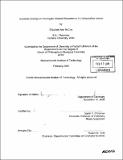Substrate analogs to investigate alkaloid biosynthesis in Catharanthus roseus
Author(s)
McCoy, Elizabeth Ann, Ph. D. Massachusetts Institute of Technology
DownloadFull printable version (48.90Mb)
Other Contributors
Massachusetts Institute of Technology. Dept. of Chemistry.
Advisor
Sarah E. O'Connor.
Terms of use
Metadata
Show full item recordAbstract
Terpene indole alkaloids are a class of natural products produced by plants, many of which are used clinically for the treatment of human disease. Natural products, are not produced by the organism for the purpose of treating human disease and often tailoring of the natural product scaffold results in drugs with improved properties. Precursor directed biosynthesis (PDB) describes the inclusion of biosynthetic precursor analogs in the growth media of a producing organism for the production of secondary metabolite derivatives derived from these exogenous precursors. These studies examine precursor directed biosynthesis of alkaloid analogs in Catharanthus roseus hairy roots and seedlings. All terpene indole alkaloids are derived from tryptamine and secologanin, which are coupled to form strictosidine by the enzyme strictosidine synthase (STR). Analysis of the tryptamine substrate specificity of strictosidine synthase (STR) revealed a subset of tryptamine analogs which were converted to the corresponding strictosidine analogs. The strictosidine analogs generated were processed by the next enzyme in the pathway strictosidine-p-glucosidase (SGD). With a set of accepted tryptamine substrates in hand, the precursor analogs were fed to C. roseus cultures for the production and identification of novel alkaloids produced by precursor directed biosynthesis. Representative alkaloid analogs for the major C. roseus alkaloids were produced and isolated from C. roseus cultures. The specific alkaloid analogs produced depends on the position of the modification on the tryptamine and the steric and electronic properties of the substitution. Detailed alkaloid metabolite analysis revealed bottlenecks for the production of specific alkaloids, representing the substrate specificity of enzymes which have not been examined on an enzymatic or genetic level. Furthermore, since the enzymes catalyzing the late steps in the biosynthesis of alkaloids are not known, photo-reactive tryptamine analogs and secologanin analogs containing a bio-orthogonal tag were combined to form a bifunctional probe, used to label and identify C. roseus biosynthetic enzymes in cell free extracts. The probe labeled several enzymes with the proposed biological activity necessary for the bio-transformations catalyzed in vivo.
Description
Thesis (Ph. D.)--Massachusetts Institute of Technology, Dept. of Chemistry, 2009. Vita. Includes bibliographical references.
Date issued
2009Department
Massachusetts Institute of Technology. Department of ChemistryPublisher
Massachusetts Institute of Technology
Keywords
Chemistry.